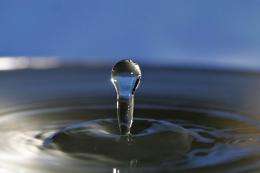July 17, 2009 feature
Why Does Water Expand When it Cools? A New Explanation

(¬È∂π“˘‘∫Org.com) -- Most of us, when we take our first science classes, learn that when things cool down, they shrink. (When they heat up, we learn, they usually expand.) However, water seems to be the exception to the rule. Instead of shrinking as it cools, this common liquid actually expands. In order to explain this phenomenon, some scientists have adopted the ‚Äúmixture‚Äù model, which purports that low-density, ice-like components dominate due to cooling. Masakazu Matsumoto, at the Nagoya University Research Center for Materials Science in Japan, has a different idea. He describes his findings in ¬È∂π“˘‘∫ical Review Letters: "Why Does Water Expand When It Cools?"
‚ÄúTheoreticians often describe that ice-like local structure emerges in the super-cooled liquid water by cooling, and increase of such heterogeneous low-density domain causes the density anomalies,‚Äù Matsumoto tells ¬È∂π“˘‘∫Org.com. ‚ÄúSuch an explanation is easy to imagine and looks plausible. Experimentalists tend to believe the theoretician‚Äôs beautiful and simple model, and interpret their data based on this.‚Äù
However, such heterogeneity as must occur in this mixed model has not been truly proven experimentally. Matsumoto set out to model super-cooled water, and see if he could discover the mechanism behind the expansion of water under conditions that should make it shrink. In a previous work (M. Matsumoto, A. Baba, and I. Ohmine, J. Chem. ¬È∂π“˘‘∫. 127, 134504 (2007)), Matsumoto offered a new method of analyzing the hydrogen bond network structure found in super-cooled liquid water. ‚ÄúI found that the structure of supercooled water can be tessellated into a variety of polyhedron-like structure, vitrites,‚Äù he says. ‚ÄúI thought the issue would be a good chance to test my method.‚Äù
“Water is a network-forming matter. You can imagine the structure of the network as a kitchen sponge,” Matsumoto continues. “The sponge structure is originally a kind of foam but membranes are lost, and only the beams - bonds - remain. In both network of water and kitchen sponge, four bonds meet at a point, or node, to form a three dimensionally connected random network. As Plateau pointed out in 19th century, four beams of a foam crosses at a node with regular tetrahedral angle - Maraldi's angle - similar to the water’s hydrogen bond network.”
Matsumoto used computer simulation to look at three ways to change the volume of the foam cells: extension of the bonds, a change in the containing angle between the bonds, and a change in network topology. “By discriminating the three contributions, the mechanism became very clear. One contributes to thermal expansion, another one contributes to thermal contraction, and the last one does not. Density maximum is a result of these competing contributions,” he explains.
“I found that the thermal volume contraction is due to the deviation of bond angles from the regular tetrahedral angle,” Matsumoto says. He also applied his former idea of vitrites to classify local structures. “Any kind of local structure shrinks when bond angle is distorted from the regular tetrahedral angle. In other words, local structural variety is not the principal factor contributing to the thermal contraction. Water shrinks homogeneously by thermal angular distortion, regardless of local structural variety.”
Right now, though, reproducing the results of Matsumoto’s simulation experimentally is a rather difficult task. “It is still very difficult to observe microscopic heterogeneity by experiments.” He hopes, though, that his simulation will at least get theoreticians and experimentalists thinking about alternatives to idea of an ice-like, low-density domain growing in liquid water through cooling. “My finding will affect to the interpretation of experimental data on super-cooled water as well as water in the vicinity of walls, solutes, biomolecules.”
Moving forward, Matsumoto hopes to use computer simulation to tackle water polyamorphism. “There are several materials which invoke liquid-liquid coexistence. Most apparent case is observed in phosphor, and tetrahedral network materials such as water, silicon, silica and germanium, are supposed to be the case, too,” he insists. “By computer simulations, many people also have reproduced the liquid-liquid coexistence. However, nobody ever explained how and why two liquid phases of a single component can share the interface.”
It appears that water is much more interesting than many of us ever could have imagined.
More Information:
Masakazu Matsumoto, ‚ÄúWhy Does Water Expand When It Cools?‚Äù ¬È∂π“˘‘∫ical Review Letters (2009). Available online: .
M. Matsumoto, A. Baba, and I. Ohmine, ‚ÄúNetwork Motif of Water.‚Äù Journal of Chemical ¬È∂π“˘‘∫ics (2007). Available online: .
Copyright 2009 ¬È∂π“˘‘∫Org.com.
All rights reserved. This material may not be published, broadcast, rewritten or redistributed in whole or part without the express written permission of ¬È∂π“˘‘∫Org.com.




















